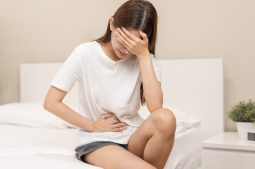
Cramps are a common symptom during menstruation, but it is not the only reason or the only time they can occur. These cramps or period-like pains can occur at any other time in the menstrual cycle, although it is understandable that they may cause alarm and concern for those women experiencing them. In this article, we will discuss cramps outside of the menstrual cycle.
What cramps without period means?
Cramps typically occur in the lower stomach or pelvis. Specifically, menstrual cramps happen during the first or second day of the period. So far, we know some factors that increase the chances of experiencing pelvic or menstrual cramps outside the period. Some of the most common causes include smoking, longer-than-usual menstrual cycles, a medical history of irregular cycles, anxiety, or depression.
Causes of cramps without a period
There are various causes that can explain why a woman experiences cramps or colic without being on her period or being pregnant. These range from normal and natural conditions to more serious medical aspects. Therefore, if you experience sudden cramps, it can be difficult to determine the exact cause. However, here are some of the most common causes:
Ovulation
The simplest and most common reason for experiencing cramps outside of your period is ovulation. Ovulation is a natural process that occurs between days 10 to 14 of the menstrual cycle, where the ovaries release an egg. While not all women experience pain during ovulation, some do describe discomfort in the lower abdomen.
Anovulation
Anovulation is the term that describes the process where the ovaries do not release an egg. A woman may experience all the symptoms of her period, such as cramps, but without actually having it.
Ovarian cysts
Ovarian cysts can also be a cause of abdominal cramps. These cysts form when the fluid-filled sacs around the ovary prevent the egg from being released for ovulation or, even if it is released, they fail to close afterward. In both cases, cramps can be a symptom.
Endometriosis
Endometriosis is a condition that occurs when the tissue lining the womb appears outside of it, potentially causing cramps or colic.
Interstitial cystitis
Interstitial cystitis, commonly known as “painful bladder syndrome,” is a condition that affects the bladder. Cramps accompanied by pain are one of its most common symptoms, along with frequent urination urges.
Irritable bowel syndrome
Irritable bowel syndrome (IBS) is characterized by abdominal pain and bloating, among other symptoms. However, these symptoms tend to improve after a bowel movement, as IBS can also involve episodes of diarrhea and constipation. Additionally, some women may experience an exacerbation of symptoms in the days leading up to their menstrual period.
Inflammatory bowel disease
Conditions like Crohn’s disease and ulcerative colitis can cause abdominal cramps along with pain and irritation in the digestive tract.
Other causes of abdominal cramps outside of the menstrual period include perimenopause, pelvic inflammatory disease, and ovarian cancer.
Treatment options for cramps
The type of treatment will vary depending on the cause. If the underlying cause is more profound, such as endometriosis, the treatment approach will depend on factors such as the patient’s age, symptoms, and progression of the disease. It is worth noting that, as a general rule, treatment options recommended are minimally invasive. However, in cases of severe and persistent symptoms, surgical intervention may be necessary.
Can early pregnancy feel like period cramps?
Abdominal cramps can be caused by menstruation or pregnancy, in addition to the medical causes mentioned earlier. How can you determine if they are due to the upcoming period or pregnancy? Implantation cramps are the most common pain when the embryo implants in the uterus, but these cramps are less painful than those caused by menstruation.







Comments are closed here.